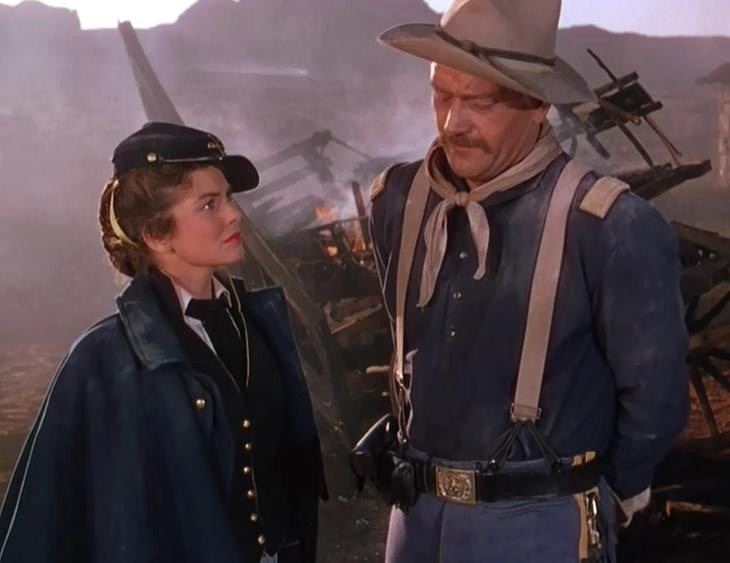 | ||
A complete filmography of John Wayne from 1926 to 1976, which also includes those films that Wayne only produced, and results pertaining to his long-running box office popularity between 1949 and 1973, during the height of his career after a decade of starring in a succession of low-budget B-movies.
Contents
Overview
John Wayne began working in films in 1926 as an extra, prop man, and stuntman, mainly for the Fox Film Corporation. He frequently worked in minor roles with director John Ford and when Raoul Walsh suggested him for the lead in The Big Trail (1930), an epic Western shot in an early widescreen process called Fox Grandeur, Ford vouched for him. Wayne's early period as a star would be brief, as Fox dropped him after only three leads.
He moved over to Columbia Pictures, where he ran afoul of studio boss Harry Cohn. As a result, Wayne was dropped from leading man to supporting player to bit player and finally down to being an extra again. After the Columbia debacle, Wayne solidified his stardom – albeit as a minor star – in a string of low-budget action films (mostly Westerns) at Warner Bros. and Universal and the "Poverty Row" studios Mascot, Monogram, and Republic. Wayne kept on friendly terms with John Ford who, as a result, gave Wayne a career boost with Stagecoach (1939).
John Wayne had achieved stardom in motion pictures by 1941 and, by the end of the decade, was one of the cinema's top ten box office attractions. During the latter half of the 1940s Wayne starred in what many film fans and critics regard as being among his finest work, notably the "cavalry trilogy" (Fort Apache, She Wore a Yellow Ribbon, and Rio Grande) for director John Ford, 3 Godfathers, also for Ford, and Red River for Howard Hawks. Wayne also began producing some of his own films during this period. The most discussed of Wayne's films during the following decade remains Ford's dark Western meditation on racism, The Searchers.
Other popular Wayne films include the seafaring adventures Reap the Wild Wind and Wake of the Red Witch and influential war movies such as Flying Tigers, The Fighting Seabees, and Sands of Iwo Jima, for which he was nominated for an Academy Award for Best Actor.
The 1950s would see Wayne continue as a major star although the artistic quality of his work varied greatly. His successes during this decade included the Ireland-set romantic comedy The Quiet Man and two classic westerns, The Searchers and Rio Bravo. Wayne also continued his producing activities during this period as well, notably with the formation of his own production company, Batjac.
In 1960, Wayne appeared in his most personal production, portraying Davy Crockett in The Alamo, which he also produced and directed.
During the 1960s and 1970s, John Wayne ranked as an American icon and one of the top box office attractions in the cinema. Wayne's output of films consisted largely of Westerns but he also ventured into other genres as well, including several films dealing with the Second World War (notably The Longest Day and In Harm's Way).
Wayne made some of his most prominent films during this period, including John Ford's The Man Who Shot Liberty Valance (1962) with James Stewart.
Wayne's political views came under harsh attack from film critics with the release of The Green Berets (1968), which Wayne produced and co-directed as well as starred in. The following year, however, he would be praised by critics for his performance in True Grit, which would earn him an Academy Award for Best Actor.
John Wayne made his last picture, The Shootist, in 1976, bringing an end to a remarkable career spanning more than 50 years, 169 feature length films, and various other television appearances or voice-overs.
Filmography
Posthumous
In 1993, Wayne appeared posthumously as George Abitbol, the central character in the French TV film La Classe américaine. The film, the story of which revolves around an investigation of Abitbol's death, consists entirely of cut-and-pasted extracts from other films, dubbed with new lines in French and transformed into a new story. Raymond Loyer, who had dubbed Wayne into French in his previous films, returned to do so one last time.
As producer only
John Wayne produced, but did not star in several feature films.
Box office popularity
Results from Quigley's Motion Picture Herald annual poll of film exhibitors would determine the year's "Top Ten Stars". John Wayne appeared on the list every time between 1949 and 1973 with one exception – 1958 – indicating that he was one of cinema's most durable stars.
